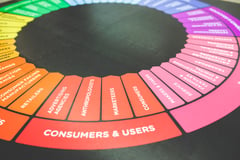Index Content
Online marketing comprises allmarketing activities that take place in the online sphere, i.e. that part of marketing that works with the use of the internet and networks.
Origin of online marketing:
Online marketing emerged, as we said, from the hand of the internet in the 90's. When the expansion of the net reached a great majority of people, who dedicate part of their time to this ethereal space that is the net, marketing workers began to think that it could be a good space to place new communication strategies. If, after all, there are clients looking in one direction, digital marketing should point towards that same direction.
And they were right, because today almost 5 billion people use the Internet, which means that 5 billion people can be exposed to your campaigns. And if online marketing has any advantage over traditional marketing, it is its wide reach. With a few exceptions in countries with network limits or major government controls, almost all websites are accessible to everyone. In addition, the translation incorporated in search engines allows the content of a page to be translated into almost any language in just a few seconds.
The evolution of marketing is intimately linked to the internet, and the evolution of the internet and the web has been given different names for each of the two stages it has gone through, and a third stage that we are currently entering: Web1, Web2, and Web3 .
Web1 is the first form in which the Internet emerged, referring to the way in which the network was organised and used in its early years, between the 1990s and the early 2000s. It was a very limited resource for users where the activity of an individual was reduced to reading and consultation, i.e. very passive actions. There were still no great tools for interacting and connecting.
In terms of marketing, what space did this web 1 leave for communication strategies? Actions focused on reading and not on interaction. In this web 1, newsletter and SEO strategies triumphed. Newsletters were perfect for this type of network, where the user was mainly dedicated to consultation, information search and enrichment. But the servers and search engines were already beginning to fill up and soon the question arose of how to make ours the most viewed among so many pages. This is where SEO or Search Engine Optimisation appears. That is, improving the conditions of our pages so that they are attractive and striking for these search engines. What these engines seek is to give the most complete, rich and appropriate page.
Therefore, the first digital marketing strategies, the first steps, were about this. Of course, since then, SEO positioning has expanded its variables and the development of new formats such as videos or photos has become part of these determining factors of positioning, as well as links.
As for newsletters, companies sought to include information about their brands on other pages, so that it could be read by web users, almost like an online catalogue. These campaigns, in a completely different format, require new specialists who know the language of the web and that of advertising adapted to the web, which has only recently been created.
Moreover, in the early years of the Internet, it is already clear that, as with books, music and cinema, each web page has an age range that predominates in its visits, which is why these campaigns begin to be segmented, seeking from the outset to adapt them to the public that will see them as much as possible.
The second step: Web 2
These innovations end up creating the so-called marketing 2.0, the marketing of the early 2000's. It coincides, more or less, with the change from web 1 to web 2 (which is orientatively situated in the year 2005).
If anything defines this new form of internet, it is the leap from the passive to the active. The user is offered the possibility of interacting, which was so much in demand, and this change completely revolutionises what was known as the internet, its basic uses and, therefore, online marketing.
These were the years of the first social networks, such as Facebook or YouTube. Participation on the web led to interaction, and so brands and companies came to the conclusion that, just as users could communicate with each other through comments, blogs and forums, they as an entity could also use the web to create a space for communication. This new space is much more direct, enjoyable and dynamic than any of the previous ones. But above all it is faster and more effective.
The evolution of this phenomenon can be seen today, when almost nobody calls on the phone to make a reservation in a restaurant, or when online commerce is as popular as shopping in a physical shop.
This second phase, close to the beginning of digital marketing, is where channels such as:
- Social Media Marketing: Social media campaigns which, in their early years, were far from the influencer marketing we appreciate today. In fact, it took a few years for social networks to include ads.
- Content Marketing: the so-called content marketing, the online marketing that is dedicated to explaining itself. This content is distributed through different formats such as video, blog, email, post, etc.
- Email Marketing: systematising the sending of emails to turn them into efficient engagement tools.
In essence, the birth of online marketing is the birth of the internet, and vice versa. The tools and strategies that digital marketing currently has may seem similar to these first ideas, but they are far from identical. The current processes for attracting customers are the result of market research, the discovery of new functionalities and the joint creation, between companies and customers, of a new space with a completely different language that has revolutionised marketing as it was known, while at the same time making use of its most classic tools.




